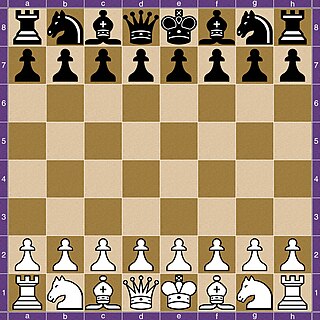
Aron Nimzowitsch was a Latvian-born Danish chess player and writer. He was the foremost figure amongst the hypermoderns and wrote a very influential book on chess theory: My System. In the late 1920s, he was one of the best chess players in the world.

A chess opening or simply an opening is the initial stage of a chess game. It usually consists of established theory; the other phases are the middlegame and the endgame. Many opening sequences have standard names such as the "Sicilian Defense". The Oxford Companion to Chess lists 1,327 named openings and variants, and there are many others with varying degrees of common usage.

The Sicilian Defence is a chess opening that begins with the following moves:
The zwischenzug is a chess tactic in which a player, instead of playing the expected move, first interposes another move posing an immediate threat that the opponent must answer, and only then plays the expected move. It is a move that has a high degree of "initiative". Ideally, the zwischenzug changes the situation to the player's advantage, such as by gaining material or avoiding what would otherwise be a strong continuation for the opponent.
Eric Schiller was an American chess player, trainer, arbiter and one of the most prolific authors of books on chess in the 20th century.

The Alekhine's Defence is a chess opening that begins with the moves:

The Blackmar–Diemer Gambit is a chess opening characterized by the moves:

The Scotch Game, or Scotch Opening, is a chess opening that begins with the moves:

The Queen's Gambit Accepted is a chess opening characterised by the moves:

In chess, the Sicilian Defence, Alapin Variation is a response to the Sicilian Defence characterised by the moves:
ChessCafe.com is a website that publishes endgame studies, book reviews and other articles related to chess on a weekly basis. It was founded in 1996 by Hanon Russell, and is well known as a repository of articles about chess and its history.

In chess, there is a general consensus among players and theorists that the player who makes the first move (White) has an inherent advantage. Since 1851, compiled statistics support this view; White consistently wins slightly more often than Black, usually scoring between 52 and 56 percent. White's winning percentage is about the same for tournament games between humans and games between computers; however, White's advantage is less significant in blitz games and games between novices.

The game of chess is commonly divided into three phases: the opening, middlegame, and endgame. There is a large body of theory regarding how the game should be played in each of these phases, especially the opening and endgame. Those who write about chess theory, who are often also eminent players, are referred to as "theorists" or "theoreticians".

Ashot Nadanian is an Armenian chess International Master (1997), chess theoretician and chess coach.

William John Donaldson, known as John Donaldson, is an American chess player, author, journalist and chess official. Like many of his contemporaries, he began playing in the aftermath of the World Chess Championship 1972 between Fischer and Spassky. He joined the Tacoma Chess Club in September 1972, and is still involved with the game almost 50 years later.

The Scandinavian Defense is a chess opening characterized by the moves:
A chess opening book is a book on chess openings. This is by far the most common type of literature on chess. These books describe many major lines, like the Sicilian Defence, Ruy Lopez, and Queen's Gambit, as well many minor variations of the main lines.






